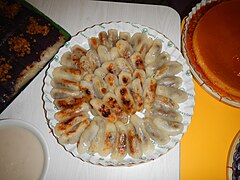  | |
| Alternative names | moche, muchi, moche balls |
|---|---|
| Course | Dessert or snack |
| Place of origin | Philippines |
| Region or state | Pampanga |
| Serving temperature | Hot |
| Main ingredients | Glutinous rice, coconut milk, mung bean paste/red bean paste/bukayo, sesame seeds |
| Similar dishes | Mache, Buchi, Palitaw |
Moche (also spelled mochi or muchi; Kapampangan: mutsi) are Pampangan glutinous rice balls with a bean paste filling. Made from galapong (ground-soaked glutinous rice) and filled with mung- or red bean paste, it is shaped into balls or ovals. Bukayo (caramelised grated coconut) may also be used. It is then boiled in water until it floats. It is then sprinkled with sesame seeds or crushed peanuts and served hot with a sauce made from sweetened coconut milk (gata).
Despite the similarity in name and ingredients, moche is not derived from the Japanese mochi or muchi. It is derived from buchi (or butsi), the Chinese-Filipino version of jian dui. Unlike Chinese buchi, the surface of moche is not browned. This dessert is closely related to the Tagalog mache and Cebuano masi.
See also
- Kakanin
- Palitaw
- Sapin sapin
- [REDACTED] Media related to Moche (Kakanin) at Wikimedia Commons
References
- "A taste of the Philippines' most unique 'kakanin'". GMA News Online. August 30, 2012. Retrieved December 3, 2018.
- "Susie's Cuisine - The Best in Pampango Kakanin". Food Reviews Manila. Retrieved December 3, 2018.
- "Filipino ricecakes, sweets, and other snacks - M". Glossary of Filipino Food. Retrieved December 3, 2018.
| Main dishes |
|  | |||||||||
|---|---|---|---|---|---|---|---|---|---|---|---|
| Noodles and pasta | |||||||||||
| Sausages | |||||||||||
| Lumpia and turón | |||||||||||
| Breads, cakes, and pastries |
| ||||||||||
| Desserts |
| ||||||||||
| Condiments and ingredients |
| ||||||||||
| Beverages |
| ||||||||||